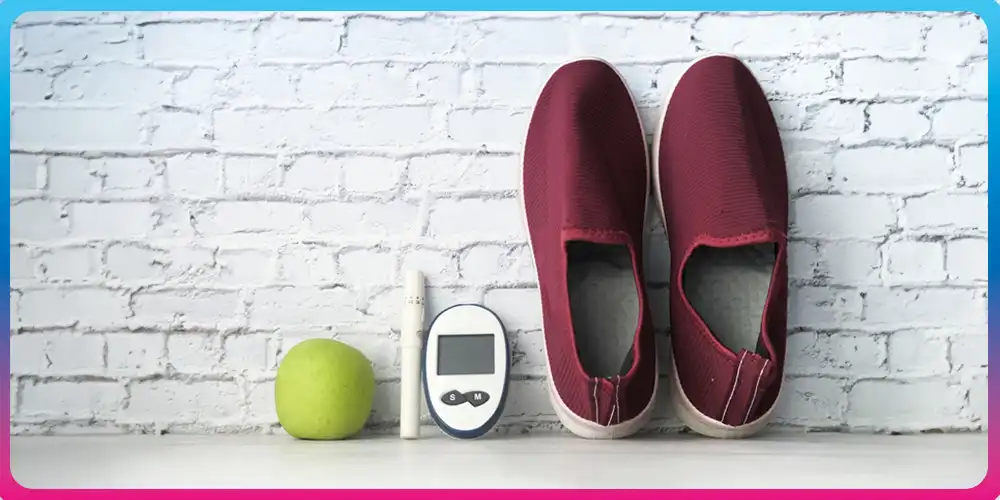Diabetes and Footwear: A Guide to Comfort and Support

Diabetes causes high blood sugar levels, which have far-reaching effects on the body.
Infact, people with type 2 diabetes are prone to foot-related complications like neuropathy (nerve damage), poor circulation to the legs and feet (peripheral vascular disease), ulcers and infections of the feet and Charcot’s foot. But foot care is the most neglected part in diabetes management.
However, things are slowly changing. From washing their feet properly every night to wearing the right socks and shoes, foot care is now becoming integral to diabetes management and the lifestyle of people with the condition.
Here’s a comprehensive guide to selecting and using proper footwear for comfort and support in people with diabetes.
To know your chances of Diabetes reversal, take the Diabetes Reversal TestDiabetes Reversal
Calculator
Diabetes and Footwear Connection
Diabetic foot, as we know, is a common manifestation of uncontrolled type 2 diabetes. The type of diabetes-related foot problems varies in different parts of the world.
For example, a lack of knowledge and awareness about diabetic foot, coupled with several individuals walking barefoot outdoors for religious or spiritual reasons in India, increases the risk of diabetes-related foot complications in the country.
A few foot-related conditions that are more likely to occur in people with diabetes are:
- Bunions
- Corns
- Fungal infections
- Non-healing ulcers after a trauma or injury
- Gangrene
Common causes of diabetes-related foot problems are:
- Wrong footwear choice (open-toe sandals, slippers, chappals, etc) that increase risk of injury and trauma
- Lack of foot care
- Cracked heel
- Walking bare feet
It is common for Indian men and women to avoid wearing socks when heading outdoors. This can result in hyperkeratotic and fissured heel or callosity of the space between the big and the adjacent toe.
For this reason, people with type 2 diabetes must wear the right shoes and socks to avoid injuries or any kind of trauma that may trigger diabetes-related foot complications.
Do People with Diabetes Need Special Shoes?
This brings us to an impending question- Do people with diabetes need special shoes? Yes! Just like picking the right shoe is important for these individuals, plenty of specialised shoes are available for them too. The three most common types are:
1. In-depth shoes
These shoes are ¼ to ½ inch deeper than regular shoes, which gives extra room to accommodate calluses or hammertoes. They also leave room for any inserts in case you need them. These shoes reduce the risk of discomfort, trauma or injury to the feet in people with diabetes.
2. Customised shoes
The best footwear for people with diabetes is customised for them. This reduces the risk of shoe bites and other injuries due to ill-fitting shoes, which are pretty common among people with diabetes.
3. Healing shoes
Healing shoes are also an excellent option which is usually given when one is healing from foot sores or surgery. They come in both open and closed-toe variants. Since open-toe variants are not recommended for people with diabetes, closed-toe shoes are an excellent choice.
Don’t struggle alone & get the expert care you deserve

What kind of shoes should people with diabetes wear?
If you or your loved one is living with diabetes, picking the correct footwear is essential. Here are some features to look for in your shoes:
1. The footwear must be soft and well-cushioned
2. Footwear with foam padding is recommended as it helps in weight distribution across the feet
3. Having air pockets helps relieve any stress on the joint and is therefore recommended
4. Comfortable arch support is essential
5. Footwear with an outer part made from carbon rubber outsole keeps it flexible and allows it to take the contour of the feet.
Tips to Pick the Right Shoe
Need help picking the right shoe? Well, here are a few tips!
1. Always pick comfort first. Wear shoes or closed sandals that fit comfortably without pinching your toes or feeling exceptionally loose.
2. Avoid picking shoes that are too loose for you as it can allow debris to enter your shoe and cause injury without you realising it.
3. Opt for closed-toe sandals or footwear whenever you step outdoors.
4. Pick soft and comfortable footwear at home because sometimes walking barefoot can cause injuries regardless of how clean your home is.
5. Avoid walking barefoot also causes germs to enter your skin, which may lead to infections in people who are susceptible to it (for example, people with diabetes)
6. Picking shoes that are an exact fit for your feet ensures your feet are not too warm or moist. This will also help prevent diabetic foot problems like ingrown toenails, hammertoes, etc.
Where to Find the Right Shoes for People with Diabetes?
Wondering where to find shoes for people with diabetes? With increased awareness about diabetic foot problems, several brands and shops now have shoes specially fabricated for people with diabetes.
You can also find customised footwear available as per need and foot deformity. If you need help finding them, consult your diabetologist or podiatrist, and they will guide you!
Which Types of Shoes or Footwear to Avoid?
1. Avoid wearing heels as it puts pressure on the ball of your feet. People with nerve damage may not realise when the ball of the feet is calloused and sore.
2. Stay clear of shoes with pointed toes, as it does not give enough room to wiggle your toes.
3. Avoid open-toed footwear and flip-flops outdoors, as they increase the risk of trauma and injuries.
4. Try to avoid footwear with straps that may cause injury.
5. Prefer shoes with laces that support your feet and avoid slip-on
6. If you find the right footwear, buy two pairs so you can alternate between the pairs every day. Each pair has different pressure points on your feet, and your footwear gets a chance to dry out, making them hygienic.
How to Find the Right Fit?
Here are some ways people with diabetes can find the right fit of footwear:
1. The best way to find the right fit for your footwear is to remove the insole and step on them. When doing so, your feet should fit comfortably on them without any overlap. If you find that your feet are more significant than the insole, the footwear will most likely be small, and your feet will get crammed inside it.
2. If you buy shoes in which you cannot remove the insole, you should be able to wiggle all your toes inside without any obstruction or discomfort.
3. People with neuropathy must go for footwear selection in the evening. The feet swell up during the evenings after a day’s work giving ample room for appropriate size selection.
FitterTake
Diabetes-related foot problems are more common than people are aware of them. If you or your loved one is living with diabetes, it is important to include foot care in your daily routine to prevent any foot-related complications of the disease.
Besides washing and cleaning your feet daily, prioritising good footwear that provides comfort, support, and safety is important.
Have diabetes and need help picking the proper footwear? Speak to us today! Just give us a missed call at 08069450746, and we will get back to you.
If you need help managing your blood sugar levels, sign up for our program. Explore and enroll for Fitterfly’s Diabetes Care Program, curated by expert diabetologists, nutritionists, fitness experts, and success coaches for effective diabetes management.
Frequently Asked Questions
Are Crocs good for diabetic feet?
Crocs are not certified orthopaedic shoes but have been found to be very helpful for people with achy feet. These shoes may be good for some people with diabetes who do not suffer from peripheral neuropathy or other advanced foot problems. If you wish to know more about the safety of Crocs for people with diabetes, speak to your diabetologist today!
Are leather shoes bad for diabetes?
Leather is soft, durable and flexible, making it a good choice of material for footwear, especially for people with diabetes.
Are orthopaedic shoes good for diabetes?
Orthopaedic shoes are designed to provide comfort and support for people with corns, bunions and other foot problems. They may be a good option for people with diabetes.
Can people with diabetes wear flip-flops?
People with diabetes must avoid flip-flops as they are open-toed, flimsy, increasing the risk of injuries and trauma. This may be dangerous for people with diabetes and associated complications like neuropathy.
Why are diabetic shoes so expensive?
If you have purchased diabetic shoes, you may have noticed the price difference between them and your regular footwear. Shoes made for people with diabetes are expensive because they are special shoes that offer extra cushioning and support to ensure proper fit.
Can a doctor prescribe diabetic shoes?
You can purchase diabetic shoes with or without your doctor’s prescription. You can consult a podiatrist or a foot surgeon if there is a foot deformity due to diabetes.
What do diabetic slippers do?
Unlike regular slippers, diabetic slippers are often broader and offer a greater cushioning effect to help reduce pressure on your feet. However, people with diabetes are advised to avoid slippers and other open-toe footwear to reduce the risk of injuries.
What are diabetic shoes and socks?
Diabetic socks and shoes are designed and fabricated to reduce the risk of skin injuries or skin breakdown in people with diabetes. This prevents diabetes-related foot problems like ulcers and ensures adequate comfort and support.
Fitterfly's Diabetes Prime Program
clinical term for Diabetes Reversal
























